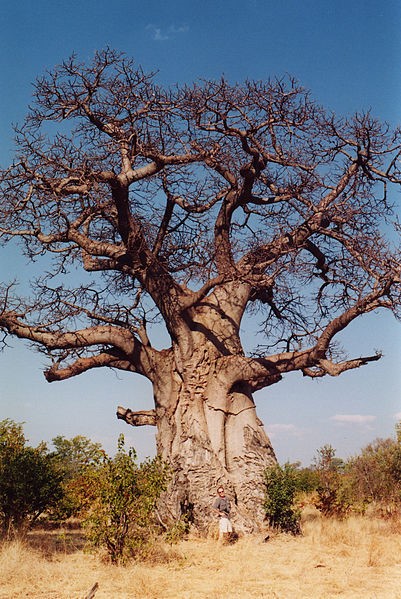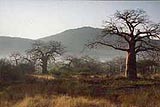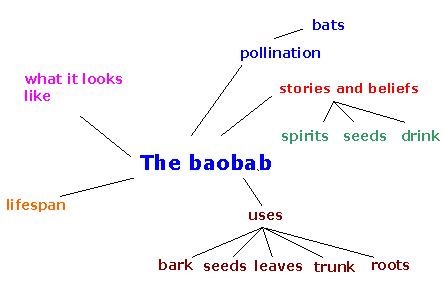Resource 5: Text on the baobab
![]() Teacher resource for planning or adapting to use with pupils
Teacher resource for planning or adapting to use with pupils
Before starting the Key Activity, you may wish to use Resource 1 as an example and discuss with your pupils how sub-headings can summarise key points.

The Baobab
The baobab is a very unusual tree. Some people think it is ugly because it is fat and for much of the year it has no leaves. It does not even seem to grow the right way up. In fact, some people who live in the land of the baobab say that it grows upside down with its branches in the earth and its roots in the air.
The baobab does things differently from other trees. Most trees use bees and birds to carry pollen grains from one tree to another so that the trees can be fertilised and make new flowers, fruit or nuts. The baobab uses bats. In early summer this tree produces big flowers with white petals. The flowers only open at night when the bats appear. The bats suck the nectar and transport the pollen from one tree to another on their wings and bodies.
Baobabs live for a very long time. Some of the largest baobabs may be over 3,000 years old.
The tree has many uses. In the past, some of the Khoi and San people of southern Africa used baobabs for their homes. They set fire to the soft insides of the trunk, making a hole big enough to live in. Even with this big hole in the trunk, the tree continued to live.
The bark of the tree has a number of uses. It can be used for making soft floor mats, paper and thread. The fibres of the bark make very strong rope.
Other parts of the tree also have their uses. If the roots are mashed, they make a soft porridge. The soft insides of the tree provide moisture for thirsty animals during the dry season. If the seeds are soaked in water for a few days, they produce a medicine that is very good for fevers. If the seeds are dried and ground up, they make a good but rather bitter coffee. If the leaves are boiled they become like cabbage and can be eaten.
Along the Zambezi, the tribes believe that when the world was young the Baobabs were upright and proud. However for some unknown reason, they lorded over the lesser growths.The gods became angry and uprooted the Baobabs , thrusting them back into the ground, root upwards. Evil spirits now haunt the sweet white flowers and anyone who picks one will be killed by a lion.
One gigantic baobab in Zambiais said to be haunted by a ghostly python. Before the white man came, a large python lived in the hollow trunk and was worshipped by the local natives. When they prayed for rain, fine crops and good hunting, the python answered their prayers. The first white hunter shot the python and this event led to disastrous consequences. On still nights the natives claim to hear a continuous hissing sound from the old tree.

In the Kafue National Park in Zambia, one of the largest Baobabs is known as 'Kondanamwali' - the tree that eats maidens. This enormous tree fell in love with the four beautiful girls who lived in its shade. When they reached puberty, they sought husbands and made the tree jealous.
One night, during a raging thunderstorm, the tree opened its trunk and took the maidens inside. A rest house had been built in the branches of the tree. On stormy nights, it is the crying of the imprisoned maidens that make people inside tremble - not the sounds of the wild animals.
Taken from: http://www.krugerpark.co.za/africa_baobab.html
The baobab is a truly amazing tree. It is one of the marvels of Africa.
Suggested sub-headings for The Baobab text
- Paragraph 1: What a baobab looks like
- Paragraph 2: How pollen is transported between baobab trees
- Paragraph 3: Lifespan
- Paragraphs 4, 5, 6: Uses of the baobab
- Paragraphs 7, 8: Stories and beliefs about baobabs
Note: There is no new information in the final paragraph. It provides a comment from the author, giving his or her opinion of this tree.
A mind map summary of The Baobab

Resource 4: A pie chart



